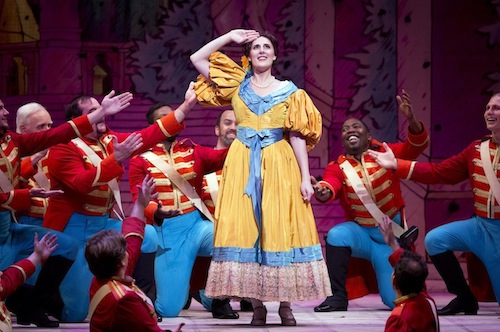Palm Beach Opera closes season with colorful and captivating Donizetti

Sydney Mancasola as Marie in Palm Beach Opera’s production of Donizetti’s “The Daughter of the Regiment.”
La fille du régiment (The Daughter of the Regiment) is a delightful operatic soufflé conceived by bel canto master Gaetano Donizetti during his sojourn in Paris.Any successful production of this opera comique requires singers with outstanding voices and comedic flair as well as a fast-paced, colorful production. A few questionable artistic decisions aside, Palm Beach Opera’s version delivers a captivating evening of light opera at its entertaining best.
The soprano and tenor roles in Donizetti’s comedy test the singers’ vocal range and theatrical acumen. At Friday’s opening night performance at the Kravis Center, Sydney Mancasola and Taylor Stayton were a delightful team with personality and voice to match.
Due to the illness of Erin Morley, Mancasola was promoted from the production’s second cast but the Metropolitan Opera National Council auditions winner was more than equal to the task. As Marie, the mascot of the military regiment, she scampered about the stage with the panache of a musical comedy veteran. Recently acclaimed as Leila in the Florida Grand Opera’s production of The Pearl Fishers, the soprano can spin rapid-fire coloratura while dancing, running or being lifted aloft by the chorus, her high notes fearless and spot on.
Her gleaming top range and effervescent lightness spun “Salut a La France” with just the right Gallic touch. Mancasola was even more effective in Marie’s two slower, more inward arias. She brought out the sadness and heartbreak at being parted from her beloved Tonio in her poignant aria near the end of the first act. Mancasola’s rich lower voice shone to impressive effect in the heroine’s second act ballad of despair as Marie longs to escape from the Bavarian chateau of the Marquise of Berkenfield.
In the pantomime that opens the second act as the free spirited Marie attempts to acquire aristocratic manners, Mancasola displayed superb comic timing and scene-stealing flair. The Offenbach-like trio was one of the evening’s highlights with Mancasola, Stayton and Peter Strummer (as Sergeant Sulpice) kicking up their heels.
Stayton was an ardent lover, his sizable lyric tenor imbued with a real sense of bel canto style. He tackled the nine high C’s of “Ah! mes amis, quel jourde de féte” effortlessly, his high range projecting with ping and solidity. He also spun mellow soft tones in Tonio’s fervent plea to the Marquise for Marie’s hand and Mancasola and Stayton’s voices blended wonderfully in duet, their timbres well matched. This young tenor evidenced real star quality.
Veteran character singer Judith Christin had the deft comic timing for the Marquise but her voice is now in tatters, the vibrato wide and unpleasant. Thomas Hammons mugged his scenes as her butler Hortensius, his bass-baritone solid in the role’s few vocal opportunities. Strummer’s seasoned baritone gave sonorous voice to Sulpice, his rapport with Christin producing some of the evening’s funniest moments.
Broadway actress Judy Kaye did a star turn in the cameo role of the Duchess of Krakenthorp, her faux German accent and imperial bearing hilarious. Stephen Sondheim’s “I Never Do Anything Twice” (from the 1976 film The Seven Percent Solution) was interpolated into the musically thin second act as a vehicle for Kaye. Her once beautiful high soprano is now a dusky mezzo but Kaye’s sense of timing and verbal acuity took full advantage of the song’s double entendres. The waltz song, however, made a jarring departure from Donizetti’s score.
The late Beni Montrssor’s cartoon cutout sets and colorful costumes from Edmonton Opera had the requisite sparkle for light opera. Despite the somewhat constricted platform that formed part of the set, Dona D. Vaughn’s staging was snappy without falling into sitcom clichés. Production numbers were staged with verve and Julie Doro’s subtle lighting gave the more intimate solos appropriate weight.
The decision to do the spoken dialogue in English and the vocal numbers in the original French was disorienting and, with supertitles, unnecessary. (Amplification was used for the spoken text.) The singers’ English diction was clear and admirable but the unaccredited text contained some very non-Gallic expressions.
Starting with a fizzy overture, Antonio Fogliani led a high-spirited performance. Unlike some other conductors, Fogliani did not make the orchestra sound like a brass band in this score, and the string lines were clear and well articulated. The male chorus was full voiced, the final ensemble reprise of “Salut a La France” done with Broadway pizzazz.
Palm Beach Opera repeats Daughter of the Regiment 7:30 p.m. Saturday and 2 p.m. Sunday at the Kravis Center in West Palm Beach. Bridgette Gan and Andrew Bidlack star in the Saturday performance. pbopera.org; 561-833-7888.
Posted in Uncategorized
Leave a Comment
Sat Mar 21, 2015
at 2:13 pm
No Comments
